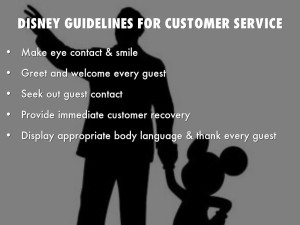Healthcare Can Learn A Lot from Disney About How to Satisfy Patients
Healthcare Can Learn A Lot from Disney About How to Satisfy Patients
 Do you remember when you first discovered the magic of Disney? Whether you’re a child or adult, chances are the Disney experience changed the perception of how a consumer should be treated. Disney follows three philosophical tenants to make sure they consistently deliver the world-class service that consumers have become accustomed to receiving:
Do you remember when you first discovered the magic of Disney? Whether you’re a child or adult, chances are the Disney experience changed the perception of how a consumer should be treated. Disney follows three philosophical tenants to make sure they consistently deliver the world-class service that consumers have become accustomed to receiving:
- Move your service from good to great
- Redefine your customer service approach
- Be courteous. It’s the right thing to do
With more than 90 years of world-renowned customer service, no one understands how to treat people better than Disney and healthcare revenue cycle executives can learn a lot about providing outstanding patient satisfaction and customer service from them.
What exactly are the things Disney does differently? It’s not the things they do entirely different; it is that they think differently. Disney pays extraordinary attention to the details surrounding general business processes and places emphasis on methods that are different from typical corporate customer service best practices. Their core service philosophy includes three key areas of focus which have helped them deliver on the Disney promise to “create happiness through magical experiences.” They are:
- Leadership: Leaders establish, operationalize and sustain the values and vision by which their organizations thrive;
- Employee Engagement: It is possible to create a workforce that consistently demonstrates desired behaviors; and
- Service: Exceptional service is achievable for every organization because exceptional service is “architected” from underlying systems and processes.
 The service strategies Disney employs are readily transferable to any healthcare provider’s environment, especially as it relates to the revenue cycle.
The service strategies Disney employs are readily transferable to any healthcare provider’s environment, especially as it relates to the revenue cycle.
The healthcare industry has relied upon continuing medical education and training to enhance the knowledge and skills of clinicians and, ultimately, to improve clinical outcomes. But using such a disciplined approach to improving patient experience is relatively new to many organizations. As the relationship between clinical outcomes and patient experience has become more established, a growing number of patient experience programs have moved beyond focusing primarily on training nurses to include physicians and a host of non-clinical staff who serve in a variety of front and back-office roles. These functions are a part of a provider’s revenue cycle; and they include coding of services, verification of insurance, third-party payer contracting, financial counseling, billing, follow-up, payment and collections.
A recent report by Jason Wolf, executive director of The Beryl Institute, titled “The Revenue Cycle: An Essential Component in Improving Patient Experience,”1 has found revenue cycle processes can have a significant impact on patient experience. According to the report, hospitals interested in improving the total patient experience should include revenue cycle processes in their administrative training initiatives.
“Healthcare organizations must recognize that efforts to improve patient encounters–whether in quality, safety or experience–require an investment in action and commitment throughout the entire organization, not just in the clinical setting,” said Wolf. “Improving the patient experience is a systemic issue where patient perceptions can be affected by cross-departmental conversations on how improvement efforts can affect both financial performance and outcomes. You could perform well in the four walls of the clinical experience, but if the revenue cycle process fails or the bill comes in and the patient or his family members feel they are treated with disrespect by revenue cycle representatives, that ultimately reflects on the institution overall,” he said. Wolf goes on to say that people are more apt to pay when they feel they are treated with dignity.
From a revenue cycle standpoint, providing an excellent patient experience doesn’t directly come from providing a stress-free billing experience or interfacing with useful technology such as a payment portal or telephone Interactive Voice Response system. It is the result of understanding patient expectations and employing the proper guidelines, strategies and customer service standards to make sure positive patient interactions.
Since the passing of the Patient Protection and Affordable Care Act (ACA) in 2010, hospitals and health systems have shown greater interest in managing consumer perceptions about the healthcare delivery experience. The new value-based reimbursement system and its revenue drivers have hospital finance executives focusing on patient satisfaction more than ever before.
The Hospital Consumer Assessment of Healthcare Providers and Systems (HCAHPS) surveys, which measure patient evaluation of the services they receive, are an essential part in the calculation of value-based incentive payments to providers under the ACA. The HCAHPS survey focuses mostly on clinical care and the facility environment, but consumers also are asked to give an overall rating of the hospital and whether they’d recommend it to others. Survey respondents shared their experiences about the clinical treatment they received and provided feedback about their non-clinical experiences with the hospital’s revenue cycle during the billing and collections process. Providers should be concerned about more than just business and finance. The non-tangible acts a hospital’s staff can put forth will have as great if not more significant impact on patient satisfaction than how easy is it to understand their billing statement or how many payment options they have available to them.
When people think about the revenue cycle, they usually think about the financial aspect of a patient interaction, such as the billing process. The revenue cycle encompasses interactions that affect patient satisfaction long before a bill is sent out. Positive impressions begin before, during and after care is provided. And they don’t all focus on dollars and cents. The best time to start to manage the patient’s expectations about their healthcare journey should begin before a patient steps through the hospital’s doors; they should clearly understand their financial obligations and how the billing process works. The earlier the communication with a patient begins, the easier it will be to keep up a high level of patient satisfaction, regardless of the clinical outcomes.
The link between patient satisfaction and staff satisfaction is one of the most important for fostering engagement and ultimately creating a culture of patient experience excellence, and that one doesn’t exist without the other in a successful program.2
In the August 2015 edition of the Patient Experience: Cultural Transformation to Move Beyond HCAHPS, Mike Murphy, president and CEO of Sharp HealthCare, a non-profit healthcare system serving Southern California, says that staff satisfaction is a critical aspect of providing an exceptional patient experience. “Our vision statement talks about Sharp being the best place to work, the best place to practice medicine and the best place to receive care. We intentionally talk about being the best place to work because we need to create an environment where our people are happy working and doing great things and focused on making the difference for our patients.”3
Experiencing industry-leading patient satisfaction is only possible if a provider’s staff is highly motivated and well-trained. Timothy R. Clark, author of The 5 Ways That Highly Engaged Employees are Different, understands how to build high performing teams that deliver the best customer care results. As Clark says, “Highly engaged employees make the customer experience. Disengaged employees break it.”
Revenue cycle employees must be motivated and trained to deliver top customer service. In a May 2015 article in Healthcare Finance titled “Revenue Cycle Tips: Improve Customer Service, Boost Collections,” Diane Stover-Hopkins, Certified Experience Economy Expert & co-author of “Wake Up and Smell the Innovation,” knows how to train a provider’s staff. She outlined seven do’s and don’ts designed to positively influence patient satisfaction results through staff training:
- Don’t limit customer experience training to online offerings. This doesn’t allow for personalized engagement, staff storytelling and dynamic memory making;
- Do take the time to incorporate patient stories where caregivers or business office staff went above and beyond to delight patients;
- Don’t underestimate the power of senior leader involvement. Ensure there is a consistent, inspirational “leader’s voice” that emphasizes the importance of the patient experience. Ensure staff at all levels see leaders honoring great service and addressing poor performance;
- Do try to tap into staff motivation for choosing healthcare as a career. Try to connect staff with their purpose-making a difference for patients;
- Don’t launch patient experience programs that ignore the differences between clinical and financial experiences and alternative One size doesn’t fit all;
- Do train and nurture internal experts to help the patient experience tools and aspirations stay readily available and vital in spite of conflicting priorities; and
- Do incorporate all five senses whenever possible when building experience design skills so that the training content is memorable. Ensure every staff member will have a compelling story to tell their family about what they learned.
Summary
Under the ACA, the financial stability of a healthcare enterprise is now affected by HCAHPS surveys, which influence Medicare’s calculation of value-based incentive payments to providers by measuring patient satisfaction. The revenue cycle has many patient touchpoints that influence the delivery of best practice customer care and have an effect on patient satisfaction and ultimately the enterprise’s compensation. Revenue cycle departmental strategies must pay extraordinary attention to the details surrounding administrative training initiatives, leadership guidance, employee engagement and customer service exceptions to experience industry-leading patient satisfaction.
Delivering quality healthcare services is complex and challenging. Experiencing high levels of patient satisfaction requires that all employees deliver on the organization’s promises. Doing so is easier said than done because one poor patient interaction can ruin the entire experience. Maya Angelou, an American author and civil rights activist, offered the best single piece of advice when treating a customer or patient. She said, “People will forget what you said, or what you did. They may even forget your name, but they will never forget how you made them feel.”
Beyond the financial remuneration, a patient provides a healthcare provider; its reputation can suffer when they receive poor patient feedback. An unhappy patient will tell between 9-15 people about their bad experience. In fact, 13 percent of dissatisfied patients will tell over 20 people about their poor experience. Losing one patient to the competition is bad enough, but losing 20 patients for every dissatisfied patient could be catostrophic.4
“The Revenue Cycle: An Essential Component in Improving Patient Experience,” is available for download at theberylinstitute.org.
- Mike Murphy, president and CEO of Sharp HealthCare, Healthleaders Media article, Patient Experience: Cultural Transformation to Move Beyond HCAHPS, http://www.healthleadersmedia.com/health-plans/slideshow-intelligence-report-patient-experiencecultural-transformation-move-beyond#sthash.TnSDT7Fs.dpbs
- Mike Murphy, president and CEO of Sharp HealthCare, Healthleaders Media article, Patient Experience: Cultural Transformation to Move Beyond HCAHPS, http://www.healthleadersmedia.com/health-plans/slideshow-intelligence-report-patient-experiencecultural-transformation-move-beyond#sthash.TnSDT7Fs.dpbs
- White House Office of Consumer Affairs report, https://www.whitehouse.gov/
________________
Phil C. Solomon is the publisher of Revenue Cycle News, a healthcare business information blog and serves as the Vice President of Global Services for MiraMed, a healthcare revenue cycle outsourcing company. As an executive leader, he is responsible for creating and executing sales and marketing strategies which drive new business development and client engagement. Phil has over 25 years’ experience consulting on a broad range of healthcare initiatives for clinical and revenue cycle performance improvement. He has worked with industry’s largest health systems developing executable strategies for revenue enhancement, expense reduction, and clinical transformation. He can be reached at philcsolomon@gmail.com
The post Patient Satisfaction Delivered the Disney Way appeared first on REVENUE CYCLE NEWS.







